(July – December 1958: Young Romance #95 – #97, All For Love #9 – #11, Personal Love #6 – #8)
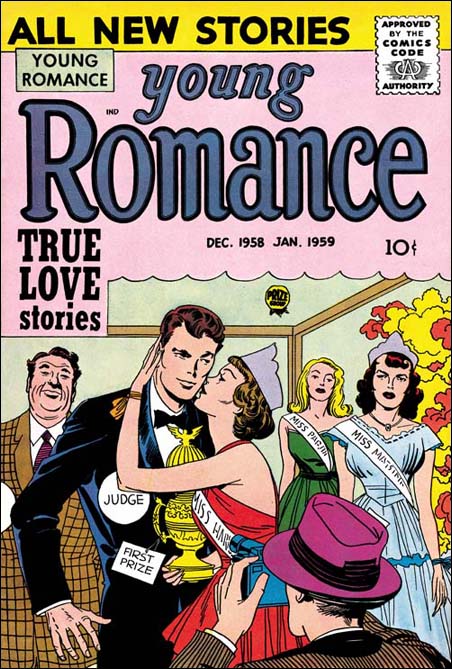
Young Romance #97 (December 1958), pencils by Jack Kirby, inks by Jack and Rosalind? Kirby
Kirby drew two of the Young Romance covers during this period (he also did Young Romance #95). Both appeared to be inked by Jack as well. But note the unusual hand belonging to the contestant wearing the blue dress. When Kirby drew covers those hands found in the periphery often were just crudely sketched. Inkers were generally artists as well and they would ink Jack’s quickly drawn hands in a way to provide them with some semblance of normality. But this example from the YR #97 cover could only be described as quite amateurish. I find it hard to believe that any professional artist would have inked such a hand. That is why I suspect that Jack’s wife Rosalind provided the outline inking. It has been reported that Rosalind did help Jack with the inking at this time, most notably for DC’s Green Arrow. Some have said that her help amounted to nothing more than filling in the black areas but other believe she did some of the outline inking as well using a pen. YR #97 convinces me that the latter proposition is correct. Rosalind Kirby may have outline inked some of Jack’s other romance art from this period but I have not noticed other such obvious examples.
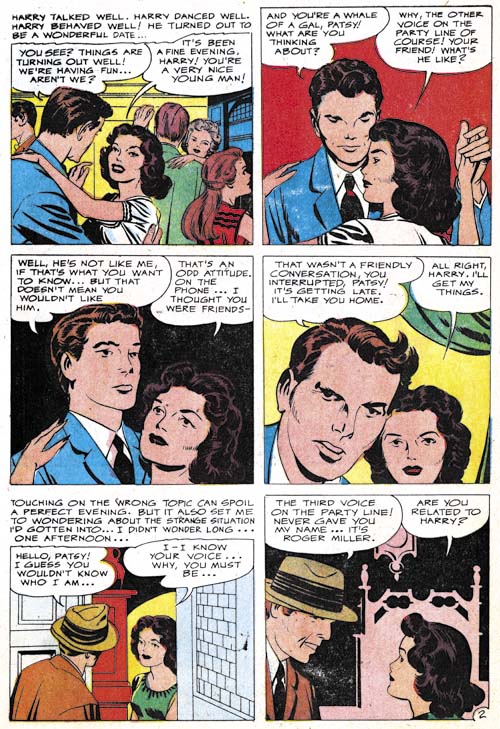
Young Romance #95 (August 1958) “Listening To Love” page 2, pencils and inks by Jack Kirby
The above page is a nice example of Kirby’s Austere inking. This style provided art that normally had a lighter overall look to it compared to earlier Simon and Kirby work. Yes panels 3 and 6 are filled with black but the figures are still light. Some characteristics of earlier inking remain. For example the arched shadow in panel 5 was often found in previous work. While I am a great admirer of the earlier style (which I call the Studio style), I find the Austere style rather beautiful as well.

Young Romance #97 (December 1958) “Hearts and Flowers”, pencils and inks by Jack Kirby
I personally find Kirby’s romance splashes from 1957 as among Kirby’s poorer pieces. But the splashes he did in 1958 are just great. The fact that Jack inked so many of them himself in 1958 provides part of the explanation about why they are so much better. However even pieces inked by others (such as the one from “Jealousy” from the last chapter) seem more interesting. It seems Kirby got his creative juices flowing again and began provided interesting compositions. The man in the foreground of “Hearts and Flowers” seems to block the reader’s viewpoint as well as the ladies. Her straight back pose seems to shout her feelings of being trapped. The man in the background occupies only a small part of the image but his presence at the focal point makes certain that the reader sees his disapproval of the other man’s actions. Great art, great story telling, great Kirby!
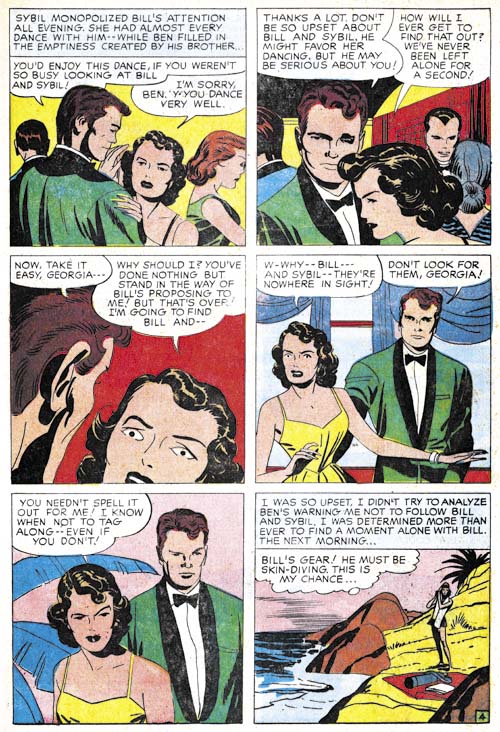
Young Romance #97 (December 1958) “Uninvited Guest” page 4, pencils and inks by Jack Kirby
I love the final romance art that Jack Kirby did for Young Romance. Most fans focus on Kirby superhero features but it is his romance work that Jack truly showed his genius. This page is a great example. While there is no action this is by no means a collection of panels of standing figures. Expression, body language and view points are all manipulated to advance the story and keep the reader interested.
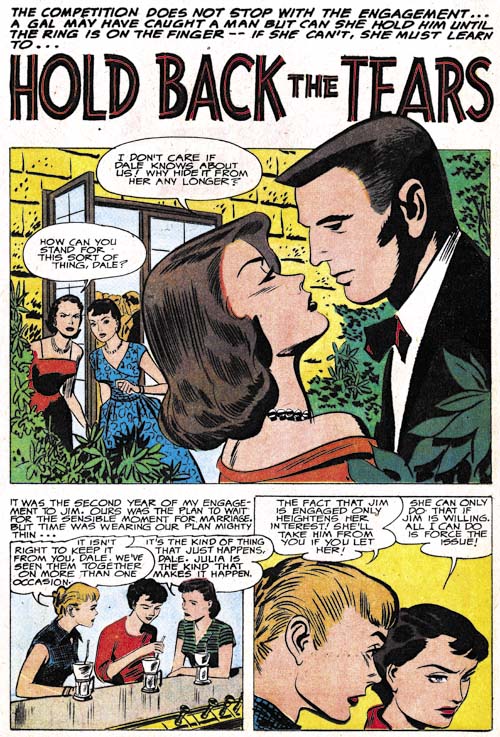
Young Romance #95 (August 1958) “Hold Back The Tears”, pencils and inks by Marvin Stein
Marvin Stein is one artist that I have reevaluated over the years. Initially I was not impressed. My earlier low opinion was largely due to his early romance art which even now I do not think that all that great. It was his crime work in particular that changed my opinion (Criminal Artist, Marvin Stein). While in some ways I find his style not as conducive for the romance genre, Stein’s romance art is still very interesting.
Note the long eyebrows found on the woman in the last panel. Such exaggerated eyebrows sometimes appear in the inking of Kirby’s pencils from 1956 and 1957. That is one of the reasons I sometimes believe Stein was the inker for much of Kirby’s work during that period.
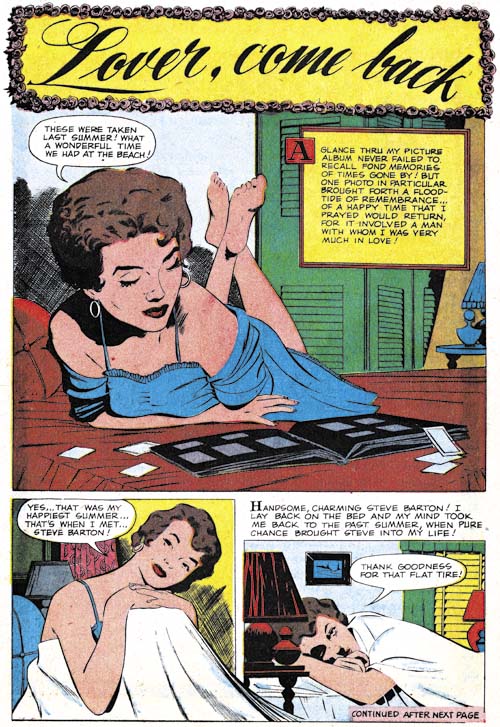
Young Romance #95 (August 1958) “Lover, Come Back”, art by unidentified artist
Some of the yet unidentified artist doing romance for Prize during this period were frankly not as good compared to those used previously. There are, however, exceptions. I particularly like the work for “Lover, Come Back”. The art appears to be based on photographic reference material and not all panels are quite as successful as those from the first page. But all the art is nicely integrated so that the swiped parts are not so noticeable. There is another story from the same issue (“A Young Man’s Fancy”) that I believe was done by the same artist. While that story also appeared to be in parts based on photographs it was not so successfully integrated. In fact the results was pretty much a disaster.
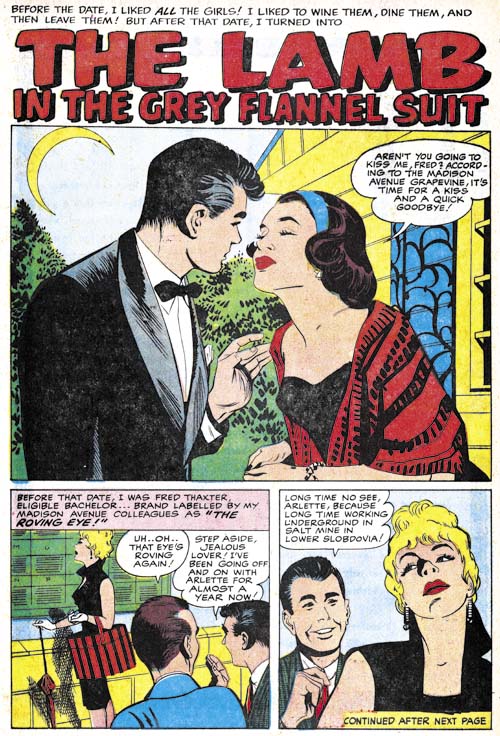
Young Romance #97 (December 1958) “The Lamb In The Grey Flannel Suit”, art by unidentified artist Paul Reinman
Another interesting but unidentified artist appearing in Young Romance. I have not noticed any other work by the same artist. Reinman did two other stories during this period and would play an important roll in futher issues of Young Romance.

All For Love #9 (August 1958) “Portrait of a Broken Heart”, art by unidentified artist
This artist appears fairly frequently in All For Love and Personal Love. Like Marvin Stein, he uses a rather blunt brush for his inking. However his woman are very different from Stein’s so there should be no problems confusing the two. Unlike Stein, this artist likes to use very thick outlines in places such as in the above splash on the woman’s hair and the man’s back.

All For Love #10 (October 1958) “Little Liar”, art by Ted Galindo
Ted Galindo continues to frequently appear in All For Love and Personal Love but not in Young Romance (the title still produced by Simon and Kirby). Ted provides 6 stories with most issues having one of his stories. It does not work out perfectly since Galindo appeared twice in All For Love #10 (October 1958) but not at all in Personal Love #7 (September 1958). The above page shows Ted using a tall narrow splash. While Galindo did not use such a splash panels often, tall and narrow panels do appear fairly frequently in the story pages.
Chapter 1, A New Genre (YR #1 – #4)
Chapter 2, Early Artists (YR #1 – #4)
Chapter 3, The Field No Longer Their’s Alone (YR #5 – #8)
Chapter 4, An Explosion of Romance (YR #9 – #12, YL #1 – #4)
Chapter 5, New Talent (YR #9 – 12, YL #1 – #4)
Chapter 6, Love on the Range (RWR #1 – #7, WL #1 – #6)
Chapter 7, More Love on the Range (RWR #1 – #7, WL #1 – #6)
Chapter 8, Kirby on the Range? (RWR #1 – #7, WL #1 – #6)
Chapter 9, More Romance (YR #13 – #16, YL #5 – #6)
Chapter 10, The Peak of the Love Glut (YR #17 – #20, YL #7 – #8)
Chapter 11, After the Glut (YR #21 – #23, YL #9 – #10)
Chapter 12, A Smaller Studio (YR #24 – #26, YL #12 – #14)
Chapter 13, Romance Bottoms Out (YR #27 – #29, YL #15 – #17)
Chapter 14, The Third Suspect (YR #30 – #32, YL #18 – #20)
Chapter 15, The Action of Romance (YR #33 – #35, YL #21 – #23)
Chapter 16, Someone Old and Someone New (YR #36 – #38, YL #24 – #26)
Chapter 17, The Assistant (YR #39 – #41, YL #27 – #29)
Chapter 18, Meskin Takes Over (YR #42 – #44, YL #30 – #32)
Chapter 19, More Artists (YR #45 – #47, YL #33 – #35)
Chapter 20, Romance Still Matters (YR #48 – #50, YL #36 – #38, YB #1)
Chapter 21, Roussos Messes Up (YR #51 – #53, YL #39 – #41, YB #2 – 3)
Chapter 22, He’s the Man (YR #54 – #56, YL #42 – #44, YB #4)
Chapter 23, New Ways of Doing Things (YR #57 – #59, YL #45 – #47, YB #5 – #6)
Chapter 24, A New Artist (YR #60 – #62, YL #48 – #50, YB #7 – #8)
Chapter 25, More New Faces (YR #63 – #65, YLe #51 – #53, YB #9 – #11)
Chapter 26, Goodbye Jack (YR #66 – #68, YL #54 – #56, YB #12 – #14)
Chapter 27, The Return of Mort (YR #69 – #71, YL #57 – #59, YB #15 – #17)
Chapter 28, A Glut of Artists (YR #72 – #74, YL #60 – #62, YB #18 & #19, IL #1 & #2)
Chapter 29, Trouble Begins (YR #75 – #77, YL #63 – #65, YB #20 – #22, IL #3 – #5)
Chapter 30, Transition (YR #78 – #80, YL #66 – #68, YBs #23 – #25, IL #6, ILY #7)
Chapter 30, Appendix (YB #23)
Chapter 31, Kirby, Kirby and More Kirby (YR #81 – #82, YL #69 – #70, YB #26 – #27)
Chapter 32, The Kirby Beat Goes On (YR #83 – #84, YL #71 – #72, YB #28 – #29)
Chapter 33, End of an Era (YR #85 – #87, YL #73, YB #30, AFL #1)
Chapter 34, A New Prize Title (YR #88 – #91, AFL #2 – #5, PL #1 – #2)
Chapter 35, Settling In ( YR #92 – #94, AFL #6 – #8, PL #3 – #5)
Appendix, J.O. Is Joe Orlando
Chapter 36, More Kirby (YR #95 – #97, AFL #9 – #11, PL #6 – #8)
Chapter 37, Some Surprises (YR #98 – #100, AFL #12 – #14, PL #9 – #11)
Chapter 38, All Things Must End (YR #101 – #103, AFL #15 – #17, PL #12 – #14)


Nice Orlando splash! Looking forward to the feature piece – I did’t care much for Stein’s early work either – but his lat 50s stuff is pretty cool -Re – superheroes – Kirby’s Marvel and DC work does seem get most of the attention – which is why the S&K Titan books are nice – I’d be nice if the Jack Kirby collector did something with a Romance, Crime or Western theme at one point…
‘The lamb in the flannel suit’ is by Paul Reinman
The unknown artist of The Lamb probably is Paul Reinman. I am curious you should say his work doens’t appear in any other romance book, because I seem to remember Reinman popping up all over them at a certain point. The major thing identifying this story as on eof his, is the distorted perspective of some of his faces, as if he used a mirror to draw his own expressions, but forgot to adjust for the angle of the mirror. This is evident in all of his work. Upshots, downshots, everything. The other thing reminding me of his work is the awkward sideshot of the man in the splash.
Well two for Reiman sounds pretty good. I have entered the period for which I have not much knowledge. And my remark about Reinman not noticing any other or his work applies only the issues of Prize Comics that I have reviewed so far.
Next week will feature more Orlando including one that absolutely clinches him as the artist J.O.
Well you guys are 100 percent correct. “The Lamb…” is Paul Reinman. And yes I did miss a couple of other stories that should have been attributed to him. He signed some pieces later that were done in exactly the same style. Well be seeing more of him in the next couple of chapters.
Next question… will he turn up as a Kirby inker here? I didn’t think so.
We are nearly at the end of Jack’s run for Prize romances and most of it was inked by Jack himself. There is one other inker but I believe it was Marvin Stein. There was no Simon and Kirby studio and I suspect that Young Romance was put together primarily by Joe with Jack only providing his own stories. So it is quite possible that Jack had not met Paul Reinman.
So are you saying that using Marvin Stein may have been Jack’s decision rather than the editor’s? Over at my blog I have started some speculation on this period as well. I believe my prepared in advance thoughts about that is due to be published tomorrow. The same discussion pops up at the Timely list, but the post there is so full of assumptions I just can’t bring myself to adress it. My major point at the moment is the question in what order Jack Kirby did his work between 1956 and 1959. He was known to have worked in advance when he had the possibillity and he also had the backlog of stuff tried out with Joe in 1955 after Mainline failed. In an article in TJKC I postulated the idea that Kirny may have produced the material for Black Cat Mystic #59 and #60 before he heard the title would be cancelled (it wasn’t cancelled, but held for a year and restarted in september 1957, but no one would know that a year in advance) and that the two stories appearing at Atlas in 1956 were part of the stack he had prepared for Harvey. The job number support that theory, although not having ben there I acknowledge that it can never be more than that.
But would that mean he had done the work for Alarming Tales as well? That would certainly explain why he did less for the subsequent issues. And Race for the Moon? If Kirby had pencilled it before that would explain why Joe Simon would need to find an outside inker for these stories. But what editor would buy such an insane amount of pages with having titles to put them in?
And what’s the deal with the Fly and Private Strong? Was that done in 1955 and finally used by Joe Simon in 1958? Or did Kirby have the time to do them in between is other, better paying work? And why would he stop after two issues? Why not spread it out over several issues?
Important to me is the assumption that Jack would not stop working for DC before he was fired (but would try and make new contacts if he felt it was going south) and he would not have been made to stop working before he stopped paying Schiff his royalty. Which would have to be after the actual start of Sky Masters, which fits in with his last Chalangers issue and last fantasy stories appearing somewhere in 1959, but not with his seeking work outside of DC in the second half of 1958 (except again, maybe having a look to see how things were hanging at Atlas when Joe Maneely died). But doing three issues of Race to the Moon when he could be working for DC? I jsut can’t see where those would fit in. The Prize books, I can see. He probably did as much as he could cram in on the side, making the total amount different everytime.
While Jack may not have met Reinman at this time, he certainly had met Stein. So did Joe. So there seems no way to tell who provided Stein with the art to ink. My guess is Jack since Stein would also ink the promo for Sky Masters.
I remembered you hypothesis about the Atlas stories being originally intended for Black Cat (I missed the issue of JKC that had your article). The timeline fits but there does not seem to be any evidence to support or refute the theory. I am not sure how Atlas job numbers can really address this issue after all they would have received such numbers regardless of whether they were originally meant for Harvey or for Atlas.
While I wouldn’t discount the material Jack did for Alarming Tales of being made earlier, I think it is more likely that at least a good protion of it (and Black Cat #60 as well) was created at that time and not earlier. Kirby’s inking style suggests that as well.
The timing of Russia’s Sputnik and the release of Race for the Moon leave no doubt that Kirby’s material was created new for that specific title.
The Flash did not appear until the later part of 1956. I would not expect that Archie Comics would consider launching superhero titles if not for DC’s apparent success in the superhero come-back. I see no reason to dispute Joe Simon’s statement that Archie approached him in 1958 and then Joe getting Jack to draw it.
As for why not spread Kirby’s Fly and Shield contributions over further issues, that was never a policy in the past. The SOP was to heavily feature Kirby in the early issues of a new title and then use him less in later issues. It seems to me that after Mainline failed, Jack would always respond to Joe’s requests for material for new titles. And I am really see no reason why doing RFTM while at DC would have caused Kirby any problems any more than doing the Prize romances or Harvey.
Job numbers were assigned when a script was ordered. The two stories Jack did have subsequent job numbers, which I have never seen in Jack’s case. Even when he did four stroies in a book, there’d be gaps. The only explenation to me is, that the job numbers were assigned when the stories we brought in fully done (thoudht hey could have been uninked). If Kirby was then given a war story from the pile, it would explain why that had a job number a couple of hunderd numbers lower. That’s all the ‘evidence’ I have. Plus the fact that the publication gap in Black Cat Mystic was odd. Maybe he did get his stories from Stan as an assignment and maybe he did get two subsequent stories from the pile when he brought in his first story, the war story. Or maybe he mentioned the two ideas and got an assignment to write and draw them then and there. But coming in with ready to print work seems to fit the situation and the personalities better for me.
I’m inclined to agree with the theory that those two Atlas ’56 stories were pre-prepared by Kirby because it seems right stylistically. However the job numbers really don’t provide much of a clue. There are quite a few cases of subsequent job numbers for Kirby. Yellow Claw 3 and 4 are consecutive and Kirby had consecutive job numbers in two seperate titles in 1959 (T-299 and T-300 in Strange Tales 70 and Battle 65).There are more examples in 1960 but Kirby was producing such a large percentage of the companies output at that time that that was nigh on inevitable. It really does look like one of those things we’ll never know for certain.
Ger,
As Coypucollector has pointed out, there really does not seem anything of special significance to the sequential numbers. And not just in Kirby’s case. So while it is an interesting hypothesis, I see nothing that can be used to add support to it.